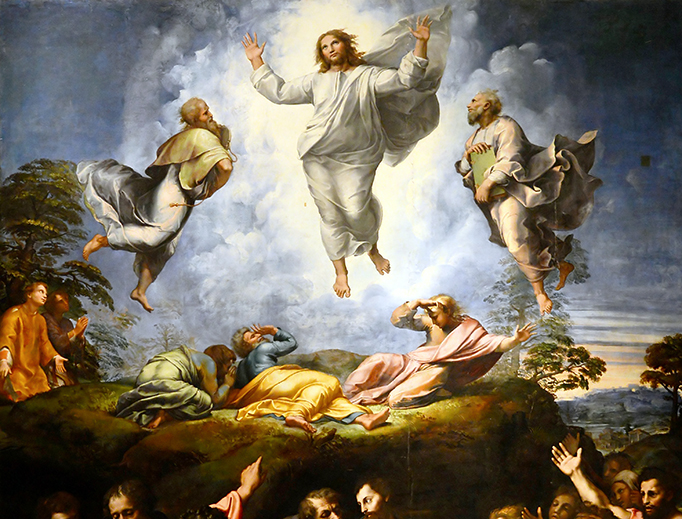Transfiguration Sunday: Glory Is Found in Self-Sacrifice
User’s Guide to Sunday, Feb. 28, the Second Sunday of Lent.

Sunday, Feb. 28, is the Second Sunday of Lent.
Mass Readings: Genesis 22:1-18 (excerpted); Psalm 116:10, 15-19; Romans 8:31b-34; Mark 9:2-10.
It’s the Second Sunday of Lent already. It’s the Sunday on which we always read the account of the Transfiguration. The Transfiguration marks the turning point in Jesus’ ministry, after which he begins to travel to Jerusalem (Luke 9:51) to meet his death. Thus, the Transfiguration is like the wedding scene from The Sound of Music, after which the tolling of the bells becomes somber and ominous, and the rest of the movie is dominated by the threat of the Nazis. During Lent, we spiritually accompany Jesus on his “death march” from Mount Tabor (the site of the Transfiguration) to Mount Calvary.
Our first reading continues our progress through salvation history, as we rehearse our family memories as the People of God, or learn them for the first time (in the case of catechumens). Last week we read about God’s covenant with Noah (Gen 9:1-18), which had echoes of Adam and the original creation. God remade Adam’s covenant with Noah, a “second Adam,” but Noah himself sinned (Genesis 9:20-27), and his descendants eventually gathered together to defy God at the Tower of Babel (Genesis 11:1-9). God dispersed them by confusing their languages, but now humanity was scattered and estranged from God. So God chose one of Noah’s descendants, Abraham (Genesis 11:10-12:3), as his instrument to restore blessing to all the families of the Earth (Genesis 12:3).
This week, we read how God tested Abraham, to make sure he was the right man for the mission to bless all humanity. God commands Abraham to sacrifice his one-and-only, beloved son Isaac on a mountain (Genesis 22:2). The ancient rabbis realized Isaac was a “young man” (Hebrew na’ar, Genesis 22:5) by now, who carried the heavy load of wood (Genesis 22:6) up the mountain. He could have overpowered his over-a-hundred-year-old (Genesis 21:5) father, so this sacrifice must have been “a death he freely accepted.” Abraham and Isaac show that they love God just like God loves humanity: to the point of offering an only-begotten son (John 3:16; cf. Genesis 22:16 RSVCE2). As a result, God spares Isaac and swears an oath to Abraham to bless all nations through his “seed” (Genesis 22:18), in Hebrew, descendant, who is Jesus (Matthew 1:1). Solomon would later build the Temple on this same mountain (2 Chronicles 3:1), and the hillock called Calvary was only a stone’s throw away.
In the Gospel, Jesus takes Peter, James and John up the mountain and is glorified before them, with Moses and Elijah as witnesses. In Jewish tradition, both Moses and Elijah were assumed into heaven, thus able to appear in bodily form to converse with the Messiah. They also represent “the Law (Moses) and the Prophets (Elijah),” a phrase referring to the entirety of the Jewish Scriptures (cf. Matthew 22:40), testifying to Jesus.
The Transfiguration is a premonition of Calvary. In both cases, Jesus is glorified on a mountain top with witnesses at his right and left — two prophets on Mount Tabor, two thieves on Mount Calvary. Jesus’ glory on Mount Tabor is easy to see, but his glory on Calvary will be much greater, even though it takes faith to see it. The Gospel of John especially insists that Jesus’ hour of death is his hour of glorification (John 12:23; 13:31-32; 17:1-5).
Love is the greatest good, and nothing has more glory than perfect love.
On the cross, God’s perfect love is perfectly displayed, a love that gives even to the point of death, even the death of an only beloved Son.
On this “Transfiguration Sunday,” we are reminded that, as disciples of Jesus, our glory will be found by giving ourselves away and accepting our own crosses. So we renew our commitment to whatever forms of prayer, fasting and almsgiving we have embraced this Lent and continue with Jesus on the road to Calvary.
















